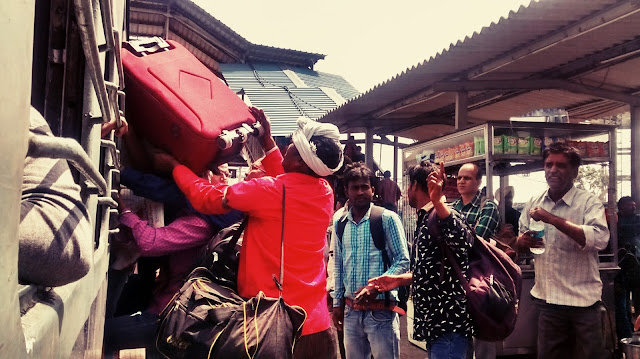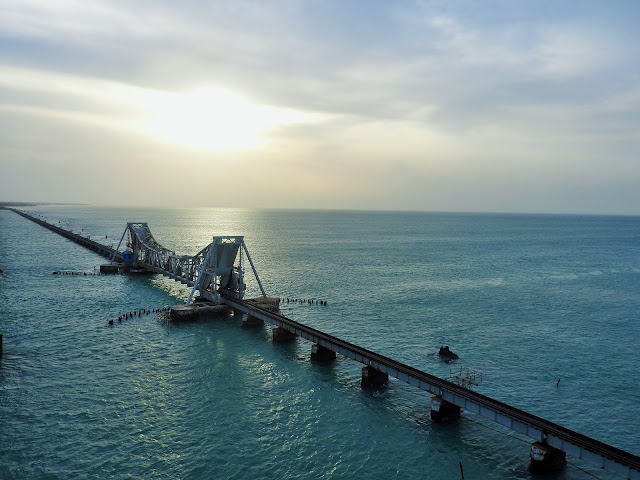If you are in India and/or following news in India, there is a chance
that you may have caught up with the brouhaha over the Talgao superfast train
between Delhi and Mumbai a couple of days ago. At 150 kilometres per hour, this soon to be launched
train is believed to reduce the travel time between the political and the
financial capital of India to under 12 hours.
Currently, the fastest train between these two cities covers the
distance of 1384 kilometres in 16 hours!
I would like to believe that the world is made up of two kinds of
people: the kind who get excited about saving 4 hours AND the kind who take 7
trains spanned over a period of 18 days to travel between the same cities! If it isn’t obvious by now, I am the kind who belongs to the latter
(if only to be the sole representative).
 |
| Train journeys seem incomplete without chai | En route to Goa - July 2015 |
My love for train travel is always met with eyebrows disappearing into
hairlines. What most people find slow and boring, I find immersive and
engrossing. Actually, my love for train travel dovetails with how much I
appreciate slow travel; though a part of me sighs at the need for a term such
as ‘slow travel’.
I mean, do most of us merely lug our bags to strike places off our
bucket-list without savouring them with our five senses? Mayhaps.
Train travel hasn’t been a newfound love in the wake of having turned
to freelancing to fund my travels. Even back in the day, when strategically
planned office leaves were the norm, I have travelled by train out of choice.
 |
| When I am not in a train or looking up trains I want to take, I catch myself reading about trains | Ladakh - June 2015 |
Maybe, I first developed a taste for train travel when I was a part of
the Jagriti Yatra in 2009.
But it wasn’t until July 2015, after completing my fellowship in Delhi
and when it was time to return that I thought of giving the Delhi-Mumbai
Rajdhani a miss and chart my own route instead.
And as with all things travel, doing it once was not going to be enough for me. So between April and May of 2016, I circumnavigated my way around the four corners of the country - yet again by train!
Perhaps out of intrigue, I have gotten asked how I go about planning my routes. So here’s two-pence based on my own tried and tested methods.
How do I begin?
Honestly, it comes down to your own preference. When I conceptualised
the route in 2015, it was about the journey and nothing but the journey. I had
webpages of the most scenic train journeys in India bookmarked on my browsers.
With each of those webpages opened on different tabs and another with Google
Maps, I played around with the scenarios I could land up with.
And I was realistic. Not every route on my wish-list was going to be
fulfilled and I was going to have to be okay with that.
The planning did not happen in chronology (obviously). Of all the
routes, the Dibrugarh-Kanyakumari Vivek Express - India's longest train journey at ~84 hours - topped the must-do list. So I
worked a little backwards, identified the day of the week the train departs
from Dibrugarh. And only then identified a train that would bring me from Delhi
to Dibrugarh!
In the same vein, I then began looking up routes in southern India
that I wanted to do and were accessible from Kanyakumari (and that is how Pamban bridge was experienced)
What about delays?
The route in 2016, on the other hand, was pre-decided by the places I
had to get to. But unlike the previous year, these were time and coordination
sensitive – like the journey from Amritsar in Punjab to New Jalpaiguri in West
Bengal where I was taking 3 trains spread out over a period of 48 hours.
Easy peasy I’d thought to myself while booking the tickets.
But on the morning of my departure from Amritsar, I reached the
railway station at 5:30 AM only to learn that the train had been delayed by 4
hours. A risk I could not afford as I had a connecting train from Delhi to
Kolkata that same evening.
So what did I do? Booked a General Class ticket and got going. Prior to that point in time, I had never travelled by the General compartment. You know what they say, right? Never say never!
 |
| The perks of a window seat in a General Compartment | En route from Amritsar to New Delhi - April 2016 |
 |
| People EVERYWHERE in the General Compartment. SIGH | April 2016 |
I reached Delhi comfortably enough to get to Connaught Place and
refuel my groaning stomach. But then back at the railway station, the train to
Kolkata had also been delayed.
There was little that could be done even though I had a lot at stake.
So I did the best I could at being optimistic. The train’s arrival in
Kolkata was marked by a 5 hour delay! At that moment, I couldn’t be more
grateful for my presence of mind while booking my tickets – the buffer of 10
hours between arrival in Kolkata and my departure from there to New Jalpaiguri
had evened out the situation the delay had caused.
Moral of the story: Those have to have been the most entertaining and
adventuresome 48 hours of my life.
In spite of these experiences and perhaps because of these experiences
I have come to believe that for most part of it, time is an overrated resource.
Very self-defeatingly, it robs us of savouring our present in lieu of the next
moment.
And it’s not just train journeys.
Someday I hope to find the answer to why co-travellers feel compelled
to take off their seat belts, collect their hand luggage and make a bevy
towards the exit of the aircraft when it’s common knowledge that the aircraft
first has to come to a halt after landing!
---
